Edgar Rice Burroughs’s Mars, Part 7: A Fighting Man of Mars
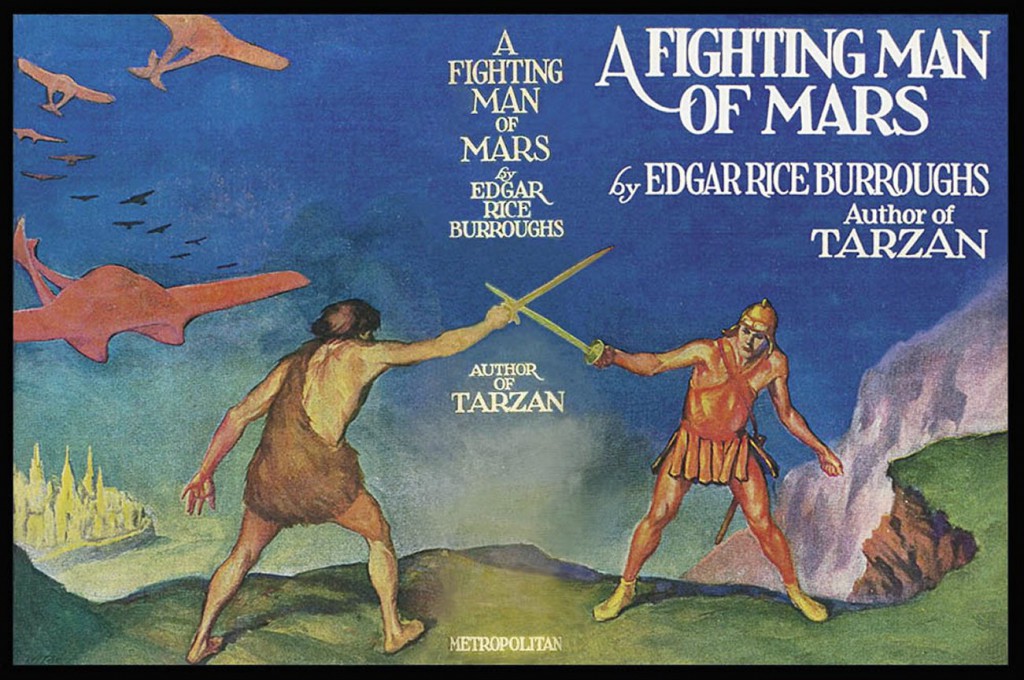 Back on Mars already?
Back on Mars already?
I’ve now crossed the equator of the eleven-book Martian series, and A Fighting Man of Mars is the first volume of “Phase #3” of Barsoom. Phase #1 is the original John Carter trilogy of the early ‘teens. Phase #2 comprises the three books where Burroughs tried new heroes. Phase #3, which covers the three books published in the 1930s, has John Carter return as the protagonist, and shows ERB spreading out the time between the books until he eventually quits writing them altogether. (Synthetic Men of Mars is the last actual novel of the series; the two following books are compilations of novellas.) Even though the first book of the new phase still features a hero other than John Carter, a new decade has arrived, and with this book it seems that ERB is seeking to re-capture the excitement of the first trilogy.
Our Saga: The adventures of Earthman John Carter, his progeny, and sundry other natives and visitors, on the planet Mars, known to its inhabitants as Barsoom. A dry and slowly dying world, Barsoom contains four different human civilizations, one non-human one, a scattering of science among swashbuckling, and a plethora of religions, mystery cities, and strange beasts. The series spans 1912 to 1964 with nine novels, one volume of linked novellas, and two unrelated novellas.
Today’s Installment: A Fighting Man of Mars (1930)
Previous Installments: A Princess of Mars (1912), The Gods of Mars (1913), The Warlord of Mars (1913–14), Thuvia, Maid of Mars (1916), The Chessmen of Mars (1922), The Master Mind of Mars (1927)
The Backstory
Burroughs started writing A Fighting Man of Mars in February 1929. Most of it he dictated onto Ediphone cylinders for his secretary to type later, a practice the author used for the rest of his career. The new book sold faster than The Master Mind of Mars, although All-Story still rejected it before Blue Book picked it up for $8,000 — seven times what Hugo Gernsback paid for Master Mind. The sale must have come as a great relief to ERB, since between writing the book and its appearance in six parts in Blue Book (April–September 1930), two major events occurred that shook up the author’s life.
The first was an acrimonious separation from A. C. McClurg, the publisher that handled most of Burroughs’s hardcover releases since 1914, including all the Mars novels. Dissatisfied with McClurg’s royalties (especially when he found out what Zane Grey was getting), Burroughs debated moving his company Edgar Rice Burroughs Inc. into self-publishing. He signed a deal with Metropolitan Services, and they released the hardcover of A Fighting Man of Mars in 1931. (The first book published through Edgar Rice Burroughs Inc., Tarzan the Invincible, was released later that year.)
The other major event was the Great Crash of October 1929. This put ERB’s investments outside of publishing into serious jeopardy, and the 1930s would become a time of uncertainty for an author who had just decided to venture outside of the New York publishing houses. ERB’s world and his writing were about to change permanently.
The Story
Although no mention is made in A Master Mind of Mars about how Ulysses Paxton communicated from Barsoom to the fictional-ERB on Earth, the book Tanar of Pellucidar introduced the “Gridley Wave” communication frequency, thus explaining how he can again send a story to his Earthly ghostwriter. This time, the introduction comprises one sentence: “This is the story of Hadron of Hastor, Fighting Man of Mars, as narrated by him to Ulysses Paxton…”
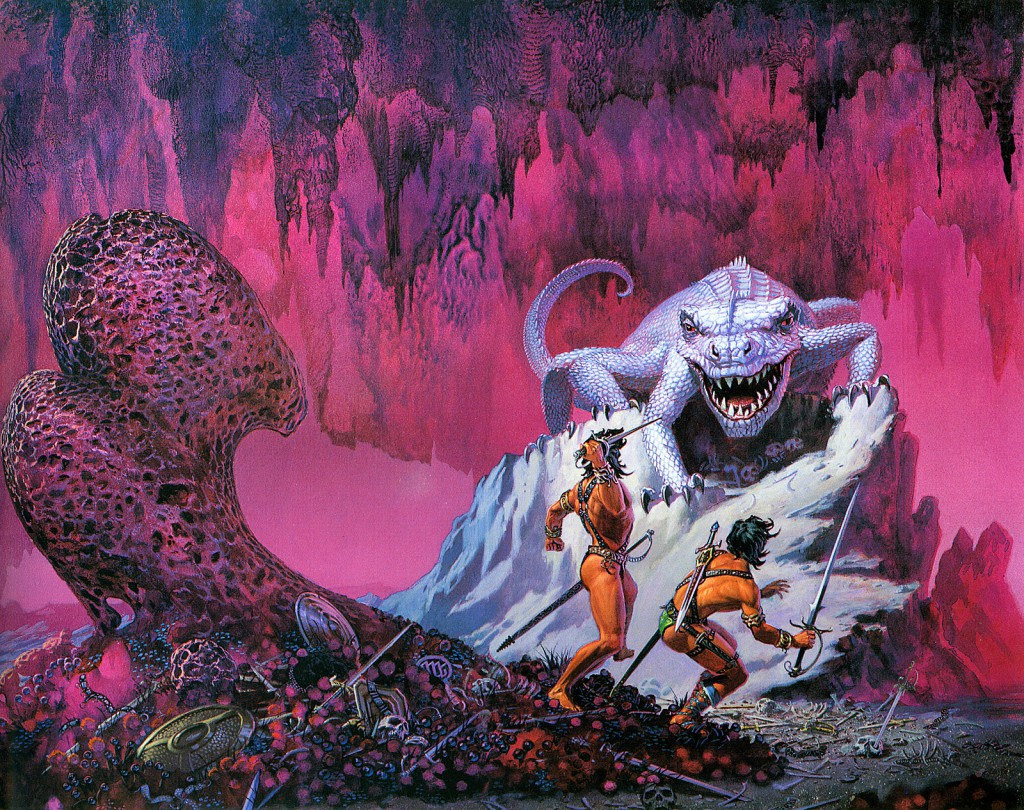 For the first time, a native Barsoomian tells of his adventures in first-person. Tan Hadron is from a family “not rich except in honor,” the son of an odwar of the city of Hastor and a princess of Gathol. Tan Hadron followed his father into military service and serves as a padwar (a lower military rank) in John Carter’s city of Helium.
For the first time, a native Barsoomian tells of his adventures in first-person. Tan Hadron is from a family “not rich except in honor,” the son of an odwar of the city of Hastor and a princess of Gathol. Tan Hadron followed his father into military service and serves as a padwar (a lower military rank) in John Carter’s city of Helium.
Hadron falls madly in love with Sanoma Tora, daughter of an odwar, who shows little interest in Hadron’s suit because he is a low padwar. When mysterious men kidnap Sanoma Tora, Hadron swears he will go rescue her. Her father promises her in marriage if the young man succeeds. However, Hadron discovers there is more occurring here than abduction: the Warlord John Carter suspects another city is plotting against Helium. Hadron discovers from an eyewitness that Sanoma Tora’s attackers wore the armor of Tul Axtar, Jeddak of Jahar. He heads out on a flier toward the enemy city.
A shot from the radium gun of the green men of Torquas downs his flier near Xanathor, one of the ruined cities of the arid sea beds where he finds a captive red Martian woman, a runaway slave from Tul Axtar’s household, named Tavia. Hadron frees Tavia, and they escape in the same flier that brought her out to the ruined city. Although Hadron wants to go straight to Jahar to find Sanoma Tora, Tavia convinces him to first go to her native city Tjanath and prepare there to infiltrate Tul Axtar’s city.
Unfortunately, the guards of Tjanath arrest them when they arrive, believing they are Jaharian spies. In a prison pit, Hadron meets Nur An, a captive from Jahar. Nur An explains that Tul Axtar aims to conquer all of Barsoom using a deadly new weapon that instantly disintegrates metal. Hadron realizes much more than his obsession with Sanoma Tora is at stake: a fleet from Helium might at that moment be heading against Tul Axtar’s forces — and would suffer certain annihilation against the disintegration weapon.
The Jeddak of Tjanath condemns Hadron and Nur An to “The Death,” which actually is an underground river that eventually takes the two men into the valley Hohr lost in the time of a lusher Mars. From here, Hadron faces many more challenges — a city of torturers, a valley of cannibals, the crazed scientist Phor Tak who invented Tul Axtar’s disintegrating ray, and a massive battle between Helium and the Jahar with strange weapons in play. But the most bizarre adventure for Hadron is discovering his true feelings toward his companion, the resourceful Tavia.
The Positives
I suggested Edgar Rice Burroughs was consciously attempting to return to the style of the John Carter trilogy. A Fighting Man of Mars is a “back-to-the-basics” adventure featuring elements that haven’t appeared in Barsoom for a stretch: green Martian tribes, white apes, dusty ruins, a story based on Helium’s politics, one-on-one duels, even a “lost world” valley. If it was ERB’s goal to recapture some of the excitement of the earliest books, he succeeded. This is the most thrilling installment in the series since The Gods of Mars.
First-person from the POV of a Martian? Good call, Ed! This is exactly the best way to keep the energy going, thus answering my question “Should ERB Have Continued the Series?” at the end of my review of The Master Mind of Mars.
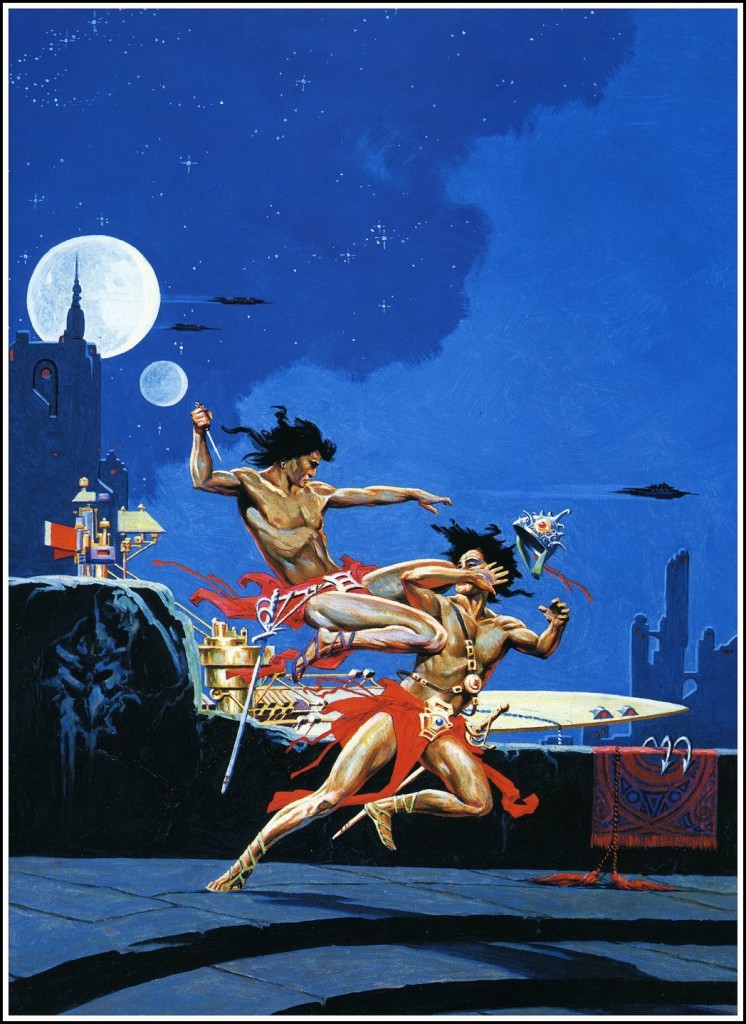 Tan Hadron is the best leading man since John Carter. He’s also the biggest romantic of Barsoom’s heroes, embracing his humble beginnings (he prefers military service over using his mother’s noble connections) and relying on his bravery and his often clever strategies over pure muscle power. This is a hero who can believably ask himself, “How might I, who might not even save himself, aspire to the rescue of another?” Or remark, “What a puny, futile thing I must have appeared confronting that towering mountain of bestial ferocity.” You would never hear this sort of realistic doubt from John Carter. Tan Hadron also credits luck and impulse for much of his success, acknowledging that pure skill isn’t always what wins the day. Hadron doesn’t go to the imbecilic extreme of Carson Napier, or even the milder foolishness of Ulysses Paxton. This is a character who readers genuinely want to see succeed. Burroughs rarely wrote underdog characters, so it’s a pleasure to have Hadron show that he could write them when he set out to do it. If only Burroughs had managed the same trick with Carson Napier.
Tan Hadron is the best leading man since John Carter. He’s also the biggest romantic of Barsoom’s heroes, embracing his humble beginnings (he prefers military service over using his mother’s noble connections) and relying on his bravery and his often clever strategies over pure muscle power. This is a hero who can believably ask himself, “How might I, who might not even save himself, aspire to the rescue of another?” Or remark, “What a puny, futile thing I must have appeared confronting that towering mountain of bestial ferocity.” You would never hear this sort of realistic doubt from John Carter. Tan Hadron also credits luck and impulse for much of his success, acknowledging that pure skill isn’t always what wins the day. Hadron doesn’t go to the imbecilic extreme of Carson Napier, or even the milder foolishness of Ulysses Paxton. This is a character who readers genuinely want to see succeed. Burroughs rarely wrote underdog characters, so it’s a pleasure to have Hadron show that he could write them when he set out to do it. If only Burroughs had managed the same trick with Carson Napier.
A huge assist for Tan Hadron’s character is Tavia. ERB believed in love at first sight a bit too much, at least when it came to his fictional creations. His heroes find their true loves after only a glance, and they never deviate from them — often spanning book after book of granite-hard loyalty that only death (or amnesia) could even tremble. But Tan Hadron doesn’t end up with his initial object of worship! Breaking his author’s trend, Hadron finds out Sanoma Tora isn’t worth his love and he ends up with Tavia, a far better love interest and one of the most likeable Martian females in the series.
The romantic tension between Hadron and Tavia is a great variant on the usual ERB artificial blocking. Instead of Hadron and Tavia mutually misunderstanding each other, they have a much more realistic drama of getting past “just being friends” while genuinely enjoying working together. Hadron’s self-doubt is focused on the unobtainable Sanoma Tora, not the dependable and active Tavia. This is one of the most realistic romantic relationships in Burroughs. It even has subtlety — although a peculiarly Burroughsian kind of subtlety — in the way Hadron wrestles with his emotions toward Tavia and tries to bury them with reassurances that she is “a friend.” Readers want this couple to get together, but enjoy watching them hack through the barriers they’ve put up against themselves, which are ones normal humans can relate to. Hadron spends too much time acting delusional about how much he “loves” Sanoma Tora (even when she outright betrays him) and putting Tavia in the Platonic friendship role, but there’s more genuine romance here than any of the previous three books.
Most of the plot mechanics come from the standard Barsoomian bag of tricks, but the kidnapping of Sanoma Tora is only important to initially motivate Hadron. Otherwise, the massive Martian war that springs up has little to do with her, and that’s a positive because it throws off the “kidnapped princess” ploy already done to death. Sanoma Tora gets Hadron into the story, and then kindly merges into the background to let a better story develop.
The double finale is a great way to end the book. First, the Battle of Jahar delivers thrilling naval combat absent since Thuvia, Maid of Mars, and Hadron’s use of psychological strategy against the Jaharians is exciting the see. Immediately after this epic clash, the story goes for the personal one, as Hadron faces Tul Axtar alone to rescue Tavia.
Burroughs’s writing is often beautiful in A Fighting Man of Mars, especially in the way he depicts Hadron’s thoughts and his descriptions of cities and gardens. Although “purple” by modern standards, they still sing on the page and bring back the Romantic image of Mars that was mostly missing in the narrow Master Mind of Mars. In fact, reading this book made me realize even more the failings of Master Mind; it wasn’t just that the book lacked action, it also lacked any kind of exciting writing outside of Burroughs having jests at the expense of a silly religion. Just this sensual flashback to what Barsoom was once like in A Fighting Man bests anything in the previous book, and seems to predict the Mars of Leigh Brackett’s masterpiece The Sword Rhiannon:
Here and there a roof of a building had fallen in, but for the most part they remained intact, dreaming, doubtless, of the wealth and beauty that they had known in days of yore, and in imagination I could see the gorgeous sleeping-silks and furs spread out in the sunlight, while the women idled beneath gay canopies of silks, their jeweled harnesses scintillating with each move of their bodies. I saw the pennons waving from countless thousands of staffs, and the great ships at anchor in the harbor rose and fell to the undulations of the restless sea. There were swaggering sailors upon the avenues, and burly fighting men before the doors of every palace. Ah, what a picture imagination conjured from the death-like silence of that deserted city…
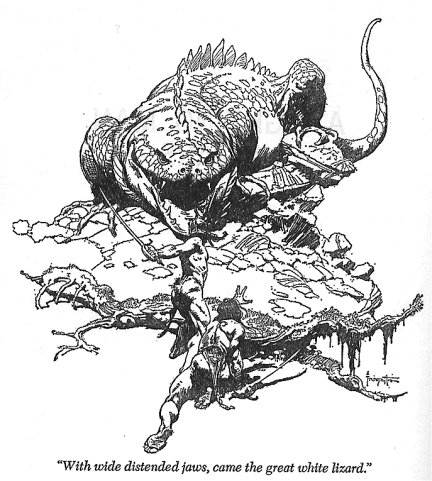 What a picture indeed. Thank you for this, Mr. Burroughs.
What a picture indeed. Thank you for this, Mr. Burroughs.
This description draws attention to another winning feature: Barsoom as both a living and dying world. Not since the John Carter trilogy has Burroughs brought so much atmosphere (or the lack of a literal atmosphere) to his fantasy planet. The edge of doom that made The Gods of Mars so potent and the victory of The Warlord of Mars so powerful has returned. The valley Hohr adds to this theme, as it gives a glimpse of what Mars once was like. The valley might have carried half a novel all on its own.
The city of torture and disfigurement, Ghasta, is one of ERB’s more grotesque ideas. The city doesn’t hang around for long and serves as a bump in the road for Hadron and Nur An, but perhaps Burroughs was concerned about getting too revolting in describing the way the ruler of Ghasta purposely deforms the women of his city.
Having the green Martians back, even for only two chapters, is fun. It’s easy to forget how crucial they are to Mars as a setting until they’ve taken a powder for a few books. Same goes for the white apes.
The Negatives
Although A Fighting Man of Mars has a good supply of interesting ideas — the deformity culture of Ghasta, the cannibals of U-Gor, the super-weaponry at Tul Axtar’s command, the weird valley Hohr and its spider hordes — it lacks a grand “big idea” at its center. All the previous Mars novels had a core imaginative notion; here we only have scraps of them. The novel operates instead on fast-moving action and interesting characters; not the worst trade-off, but it is a loss.
Burroughs seems to make a concentrated effort to “throw off” new readers in the first two chapters, as he spits out a steady stream of unimportant ranks in the Helium army, reckless use of Barsoomian measurement terms, and a pointless dissertation on the new technology of the fliers.
The plot is … well, the plot. Although an exciting read, the narrative is still an episodic “one damn thing after another,” the only place where The Master Mind of Mars has the advantage. At least one episode, where Hadron and Nur An escape prison and then get caught again at the beginning of the next chapter, is pointless. It’s exciting, but still plot-padding. Burroughs should have directed more time to the valley Hohr, which drips with promise but appears in only a single chapter. Love those spider masses, though.
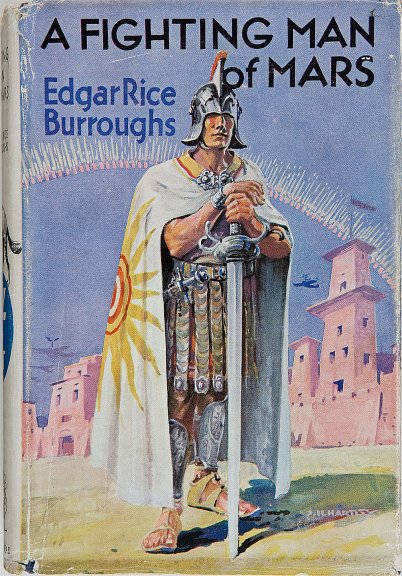 I wonder if ERB forgot he wrote Thuvia, Maid of Mars, because both this book and The Chessmen of Mars start with the exact same opening of a reluctant hero making his move on a hesitant beauty, only to have her immediately kidnapped and the blame falling on him, forcing him to fly off solo to rescue her, and then immediately crashing before an ancient city. Sanoma Tora isn’t a princess, nor does she end up the hero’s love, but this is still a “Rescue the Princess” plotline. (A role Tavia helps fill when Sanoma Tora slips into the background.) This isn’t a devastating problem since the story eventually develops a different direction, and the more Sanoma Tora get sidelined, the better it gets.
I wonder if ERB forgot he wrote Thuvia, Maid of Mars, because both this book and The Chessmen of Mars start with the exact same opening of a reluctant hero making his move on a hesitant beauty, only to have her immediately kidnapped and the blame falling on him, forcing him to fly off solo to rescue her, and then immediately crashing before an ancient city. Sanoma Tora isn’t a princess, nor does she end up the hero’s love, but this is still a “Rescue the Princess” plotline. (A role Tavia helps fill when Sanoma Tora slips into the background.) This isn’t a devastating problem since the story eventually develops a different direction, and the more Sanoma Tora get sidelined, the better it gets.
After all the grim anticipation piled onto it, the execution method known as “The Death” is a crushing disappointment. The irony that the rulers of Tjanath don’t know that it’s nothing more horrifying than drowning in a river is poor compensation considering the imaginatively weird things Burroughs might have done instead. At least it leads to the white lizard and the valley Hohr.
Tul Axtar gets plenty of build up as a villain. But he makes little impression when he finally makes his entrance; and since he’s a coward he never poses a strong threat to Hadron. Weapons inventor Phor Tak ends up disappointing as well, despite his juicy mad scientist speeches. The glorious “flying death” he invents to wreck fleets all across Mars never get used at all.
Turns out in the last two paragraphs that Tavia is actually a princess, and she never knew it! Well … boo, hiss. Come on, Ed, can’t you just let some commoners get married for once? Hadron and Tavia made a great couple without her turning into royalty. This adds nothing.
None of these problems overwhelm the good time this book offers. I hope readers of the Barsoom novels hold on long enough at least to get this far, because A Fighting Man of Mars is what great pulp is all about.
Craziest bit of Burroughsian Writing: “…and then, espying luscious fruit hanging in great clusters from some of the trees, and bushes loaded with berries, we subordinated the aesthetic to the corporeal and set forth to supplement our meal of raw fish with the exquisite offerings which hung so temptingly before us.”
Best Moment of Heroic Arrogance: Hadron isn’t arrogant, but suddenly attacking and killing his prison guard when he has no escape plan whatsoever is pretty gutsy.
Times a “Princess” (Female Lead) Gets Kidnapped: 4
Best Creature: The white lizard of the underground river.
Most Imaginative Idea: The disfigurement culture of Ghasta.
The Smartest Thing Anyone Has Yet Said on Mars: “…often we act rightly upon impulse and then credit the result to superintelligence.”
Should ERB Have Continued the Series? Hell, yeah. Any doubts I had before with Master Mind are now gone. Fight on, Ed!
Next: Swords of Mars
Ryan Harvey is one of the original bloggers for Black Gate, starting in 2008. He received the Writers of the Future Award for his short story “An Acolyte of Black Spires,” and his stories “The Sorrowless Thief” and “Stand at Dubun-Geb” are available in Black Gate online fiction. A further Ahn-Tarqa adventure, “Farewell to Tyrn”, is currently available as an e-book. Ryan lives in Costa Mesa, California where he works as a professional writer for a marketing company. Occasionally, people ask him to talk about Edgar Rice Burroughs or Godzilla in interviews.
Nice recap. This was always one of my favorite books in the series as well.
Excellent as always, Ryan.
I’ve recently been reading some of ERB’s other non-Martian novels, such as the Pellucidar ones, “Outlaw of Torn,” “The Lost Continent” and “The Mad King,” and it is surprising how often he resorts to one or usually both of the following plot devices: either the initial “artificial blocking” and “mutual misunderstanding” (to quote you) of the heroine and hero or else the “Rescue the Princess” plotline (again, to quote you).
Having said that, a city of torturers, valley of cannibals, a crazed scientist with a disintegrating ray and a white lizard sound too good for me not to eventually put this book on my reading list.
[…] for it, half of what the publisher paid for Carson of Venus and a seventh what he received for A Fighting Man of Mars eight years earlier. ERB’s gloomy attitude toward his work had disturbing real-world […]
[…] Thuvia, Maid of Mars (1916), The Chessmen of Mars (1922), The Master Mind of Mars (1927), A Fighting Man of Mars (1930), Swords of Mars (1934–35), Synthetic Men of Mars […]
[…] Thuvia, Maid of Mars (1916), The Chessmen of Mars (1922), The Master Mind of Mars (1927), A Fighting Man of Mars (1930), Swords of Mars (1934–35), Synthetic Men of Mars (1938), Llana of Gathol […]